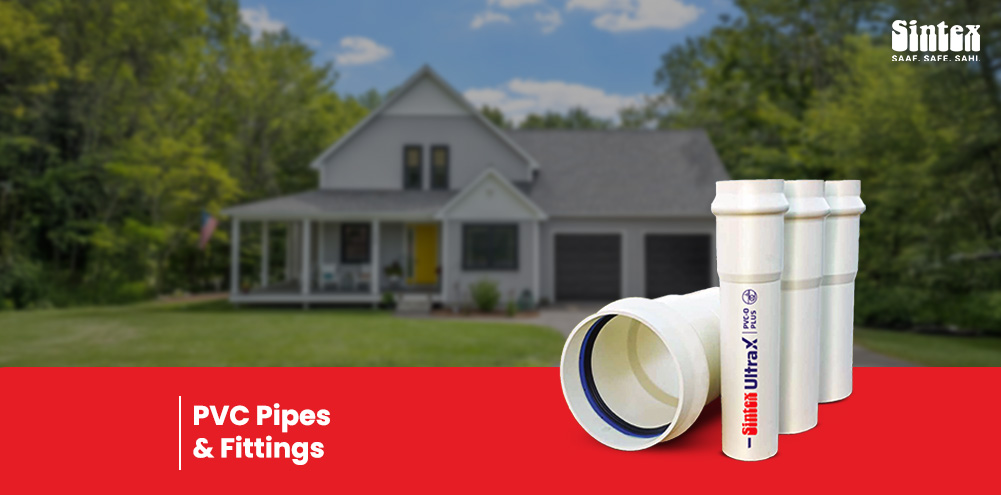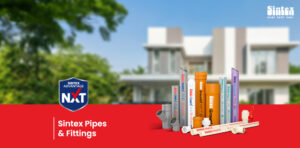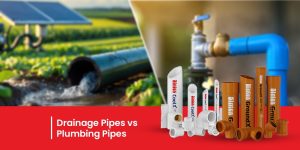PVC Pipes and Fittings: Types and Advantages
Share

Table of Contents
Behind every smooth water flow in your home or efficient irrigation in the field lies a smart and durable piping system. From bathrooms and kitchens to borewells and factories, PVC pipes and fittings are the unseen heroes powering essential infrastructure. Whether it’s a water pipe, drainage pipe, or electrical conduit, PVC remains a popular choice across India, and Sintex is a name synonymous with quality and trust.
In this blog, we’ll explore the different types of PVC pipes and fittings and the key advantages that make them a preferred choice across industries. and, most importantly, why Sintex remains one of the most reliable names in India’s PVC pipe industry.
What Are PVC Pipes?
PVC stands for Polyvinyl Chloride. The name sounds scientific, but put simply, it is lightweight, strong, and inexpensive construction-grade plastic used primarily in water piping systems.
Unlike metal pipes, PVC is corrosion-free and designed to last for ages. Whether setting up a new home, managing a commercial space, or planning agricultural irrigation systems, PVC and CPVC are used.
Common PVC Pipe Types: Explained
The world of plumbing pipes is more diverse than it seems. Here are the most prominent types based on functions:
| Type | Usage | Example |
| Pressure Pipes | For water supply systems under pressure | Overhead tanks, water mains |
| Non-Pressure Pipes | For gravity-based flow, like drainage | Rainwater or underground drainage |
| Conduit Pipes | Used to protect and route electrical cables | Electrical wiring in homes/factories |
CPVC (chlorinated PVC) is more suitable for hot water systems as it handles high temperatures and pressure better than standard PVC. For those asking what CPVC is, it stands out due to its enhanced strength and temperature handling compared to standard PVC. If you need pipes for bathrooms or kitchens where warm water flows regularly, CPVC is the smarter pick.
PVC Pipe Fittings
Pipes are vital in any plumbed building; however, they remain useless until fitted with adapters. Adapters not only hold two tubes together but also bring them into an arrangement that prevents leakage. They comprise the joints, elbows, connectors, and coupling rods that would complete a tube skeleton into a fully functional pipework.
Types of fittings include:
- Elbows (90° and 45°) – For changing flow direction.
- Tees – For branching pipe flow
- Couplers – To connect pipes of the same size.
- Reducers – For linking pipes of different sizes.
- End caps – To seal off pipe ends.
Besides these advantages of PVC pipes, they also enjoy extra bonuses like certified quality marks such as the ISI mark, which serves as proof for meeting the outlined criteria while ensuring durability when improperly handled, making them ideal even in tough usage environments like construction sites or outdoor installations.
Top 5 Advantages of PVC Pipes
1) No Rust, No Fuss
When looking for cost efficiency between metal tubes and waterline pumps, opt for PVC branches or tap lines since those do not corrode or scale over time, ensuring long-term robust solutions for waterways around homes.
2) Budget-Friendly
They’re affordable to install and maintain. Want to know the PVC pipe price? Sintex offers pipes at affordable prices, making them an excellent option for homeowners and builders alike.
3) Easy to Install
PVC pipes are lightweight and flexible. “Cut, glue, and fit” instead of welding or using heavy-duty tools saves time and labour costs.
4) Chemical & Weather Resistant
Whether buried underground or above ground, PVC is well-known to withstand most chemicals and weather elements, making it suitable as a drainage pipe or even a PVC drain pipe in complex situations.
5) Long Life, Low Maintenance
With a life span of over 50 years, they require minimal upkeep. Once installed, they do their job silently and efficiently.
PVC Pipes Uses in Everyday Life
Where exactly are all these pipes applied? Pretty much everywhere.
- Residential Plumbing: Kitchen, bathroom, garden water supply
- Commercial Projects: Office restrooms, industrial pipelines
- Agricultural Irrigation: Watering systems for farms
- Drainage Systems: Rainwater harvesting, underground sewage
- Electrical Applications: Cable conduit pipes
So, next time you turn on a tap or flush a toilet, there’s a good chance a PVC pipe is behind the scenes.
Why Choose Sintex for PVC & CPVC Pipes?
Builders, plumbers, and homeowners have trusted Sintex for decades for its unparalleled expertise. Our plumbing pipes and fittings are designed to meet the highest durability, pressure handling standards, and chemical resistance, making them a trustworthy product.
Quick Glance at Sintex PVC & CPVC Pipe Pricing (2025 Price List):
| Product | Price (Approx.) |
| CPVC Pipes SDR 11 (1/2″) | ₹60 to ₹500+ |
| PVC Drain Pipes (4″-6″) | ₹310 to ₹417 |
| CPVC Fittings (Tees, Elbows) | ₹17 to ₹150+ |
Their pipes are ISI-certified, durable, and tested for Indian conditions. If you’re serious about long-lasting performance and low maintenance, Sintex should be on your shortlist.
Things to Consider Before You Buy
- Application: Are you using it for hot water, cold water, or drainage?
- Pressure: Know how much pressure your system requires.
- Size & Length: Pick the correct diameter and length based on usage.
- Installation Method: Check if you need solvent cement or threaded connections.
Final Words
Choosing the proper piping is like selecting the veins for your building. Do you seek a challenge? Something demanding yet trustworthy? Need high efficiency? You get all that with PVC pipes, but when you add Sintex into the equation, you gain quality, affordability, and peace of mind.
Your flow matters, from kitchen taps to farm irrigation and PVC pipe to drainage pipe systems, and it deserves the best.
Also, read our blog on: Unlocking the Versatility of PVC Pipes: Top Applications You Should Know





